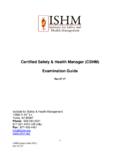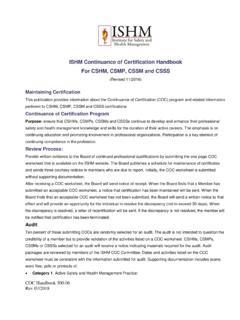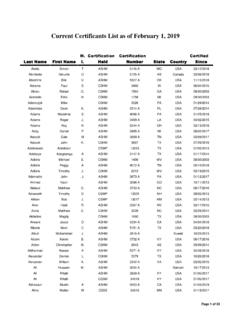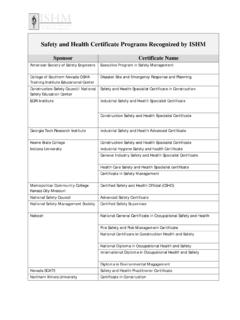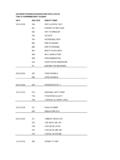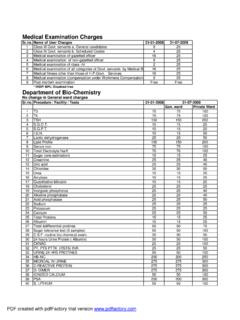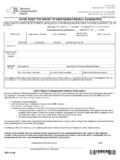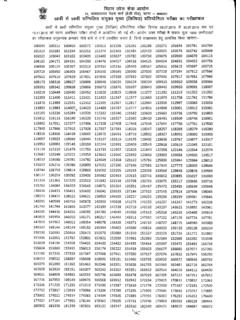Transcription of CERTIFIED SAFETY AND HEALTH EXAMINATION …
1 CERTIFIED SAFETY AND HEALTH EXAMINATION . SAMPLE QUESTIONS. The CERTIFIED SAFETY and HEALTH EXAMINATION Practice Items are intended to familiarize prospective examinees with the style and format of the CSHM EXAMINATION questions. There are 36 objective practice items contained in this Guide, whereas the actual CSHM. EXAMINATION contains 150 objective items. The 150 test items will have the following weighted breakdown. Management and Leadership Principles and Methods (21% of test/32 questions). Risk Identification, Management and Control (35% of test/52 questions). EHS Operations, Programs and Applications (28% of test/42 questions). Incident Investigation and Performance Evaluation (16% of test/24 questions). Exams administered outside the United States will be in US English.
2 Exam questions for candidates in this category will contain fewer questions that pertain only to the United States ( OSHA, NIOSH, etc.). None of these practice items will be found on the actual CSHM certification EXAMINATION . These practice items are only meant to be representative of the type of items found on the certification EXAMINATION . Following the practice items is a quick scoring key and the rationales for the answers. Remember to select the BEST answer. Good luck! I. GENERAL AND BUSINESS MANAGEMENT. 1. A hazard analysis can be used to evaluate a potential hazard; what other information should be considered? a. Injury reports b. Statistical data c. Risk assessment d. Fatality investigations 2. Which leadership style will have the most positive effect on subordinate satisfaction for employees who work on stressful, frustrating or dissatisfying tasks?
3 A. Supportive b. Achievement-Oriented c. Participative d. Contingency 3. Which leadership style will help employees to strive for higher standards of performance and have more confidence in their ability to meet challenging needs? a. Directed b. Achievement-Oriented c. Participative d. Performance 4. Which of the following is TRUE concerning goals: a. All of the following are true b. Employees who are assigned value goals perform better than those employees who are given specific goals c. Employees given moderately difficult or easily attainable goals perform better than those given high challenging goals d. Pay and feedback lead to improved performance only when they lead individual employees to set high goals 5. Which of the following are recognized strategies for multi-national companies to use in dealing with the diversity of statutory laws governing it?
4 A. All of the following b. Lobby to change the laws in each country so they are all the same c. Make all operations conform to the strictest country law d. Make operations in each country responsible for compliance with that country's laws 6. Common law differs from statutory law. Which of the following statements is TRUE? a. Statutory law passed by a legislature b. Statutory law is defined over a period of years by judges c. Common law refers to a law that is often violated d. Common law is a statute that amends a state constitution 7. What functional area is typically responsible for functions related to design, construction, standards, and repair? a. Engineering b. Facilities c. Logistics d. Research and Design 8. Who are the customers of the occupational SAFETY function?
5 A. All employees in an organization b. All employees in an organization and the community as a whole c. The SAFETY manager, supervisor, peers, and subordinates d. From the CEO-level of management to the line worker 9. Some ways the SAFETY management professional can determine training needs is to: a. All of the following b. Conduct workplace surveys 2. c. Review regularly scheduled inspections for needs d. Conduct an employee opinion survey II. EHS MANAGEMENT METHODS AND SYSTEMS. 10. The terms incidents and injuries are often used interchangeably. Actually the meanings are: a. Synonymous b. Different c. Diametrically opposed d. Identical 11. A tool that enables a team to identify, explore and graphically display the possible causes of an incident or hazardous conditions is: a.
6 A fishbone diagram b. An affinity diagram c. A matrix diagram d. An interrelationship diagram 12. The system SAFETY method, MORT, stands for: a. More Observation and Repetitive Training b. Management Oversight and Risk Tree c. Management Obstacles and Responsive Techniques d. Management Objectives and Regulatory Training 13. One method often used in system SAFETY programs for complex systems is: a. Fault tree analysis b. Fishbone analysis c. Pareto chart analysis d. Audit analysis 14. Calculate the incidences rate for a company if the recordable incidents are 40. and the total hours worked are 1,500,000: a. b. c. d. 15. Which of the following techniques would be most likely to increase the motivation and satisfaction of people at your? a. Job placement b.
7 Responsibility of workers c. Satisfaction of workers 3. d. Job enrichment 16. What are the two main causes of incidents in the workplace? a. Unsafe acts and unsafe people b. Unsafe people and unsafe machines c. Unsafe conditions and unsafe machines d. Unsafe acts and unsafe conditions 17. According to William C. Pope, the three causal factors of an incident are: a. Training, oversight, inadequate system b. Defect, management, training c. Error, defect, oversight d. Regulation, error, attitude 18. There are several factors that are often used to determine when an organization should have the services of a full time SAFETY Professional. Which of the following is generally acknowledged to be the prime-determining factor in assigning SAFETY personnel? a.
8 The incident rate of organization b. The seriousness of incidents suffered by the organization c. The potential for serious injuries in the organization d. The type of industry the organization is involved in 19. According to Pope, prior to 1960, SAFETY and incident prevention used what type of approach to reduce injuries? a. Situational Leadership Approach b. Engineering Approach c. Classical Management Approach d. Contingency 20. The main goal of Worker's Compensation law is to: a. All of the following b. To give the employee the opportunity to plead his case and speed up the waiting period for just compensation c. To eliminate negligence and product liability claims d. Compensate workers for injuries caused by incidents arising out of and in the course of employment 21.
9 Housekeeping requirements for safe construction sites include all of the following EXCEPT: a. Keeping site reasonably dry and clear of debris, scrap and protruding nails b. Providing containers for the collection and separation of waste, trash, oily rags and any other refuse. c. Removing combustible scrap at regular intervals 4. d. Storing all flammable wastes in a barrel or similar container with open top for convenient deposit and frequent removal. III. SAFETY , HEALTH , AND ENVIRONMENT APPLICATIONS. 22. Which of the following is a term used to describe the condition epicondylitis ? a. Trigger finger b. Rotator cuff c. Roofer's wrist d. Carpenter's elbow 23. The most common of the work related musculoskeletal disorders, and in economic terms, the most costly is: a.
10 Carpal Tunnel Syndrome b. Tendonitis c. Epicondylitis d. Low Back Pain 24. The delay between exposure and observable effects is _____. a. Down time b. Latency period c. Effect delay d. Synergism 25. Which analysis method is the most effective at determining potential problems in a given system? a. Preliminary Hazard Analysis b. Job SAFETY Analysis c. Fault Tree Analysis d. Failure Mode Effect Analysis 26. Dilution ventilation is used to: a. Control a contaminant at it source b. Control fumes from lead fusing c. Control low toxicity vapors d. Control asbestos 27. As one ages there is a vascular and neural degeneration of the inner ear that results in a decrease in hearing ability. This condition is called: a. Sensoneural b. Sociocusis 5. c. Presbycusis d.

